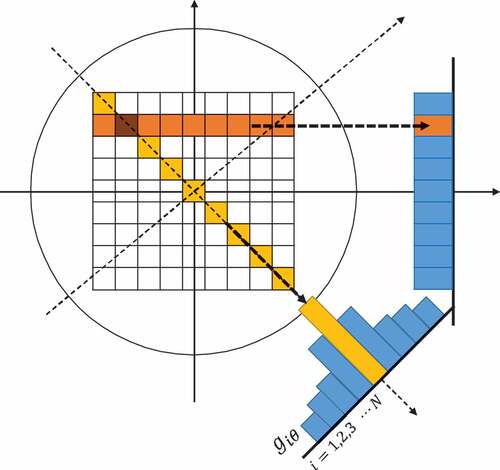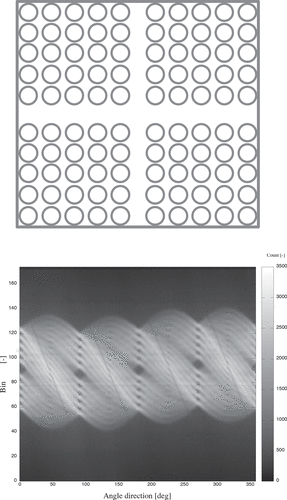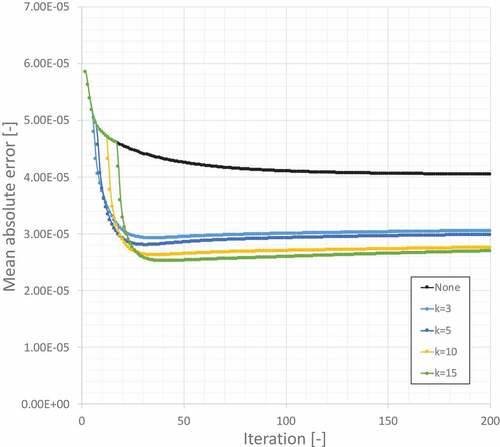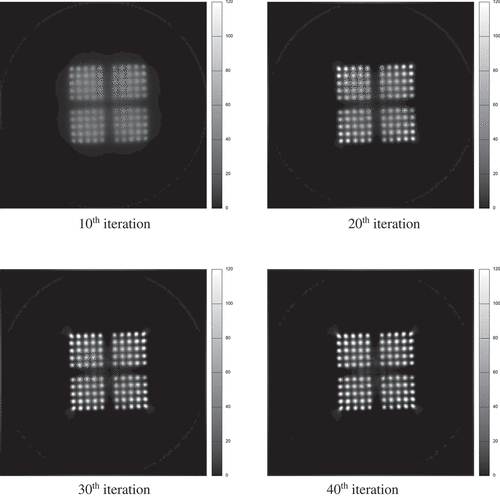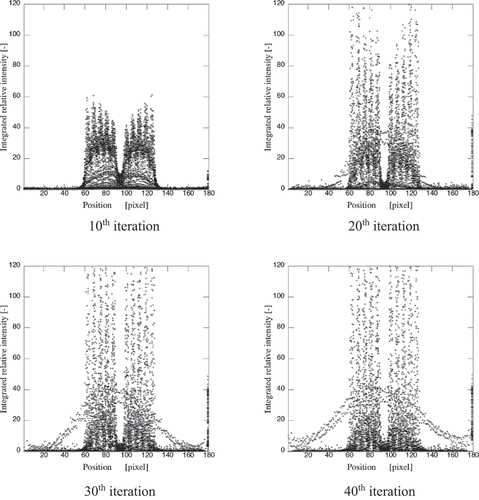 ?Mathematical formulae have been encoded as MathML and are displayed in this HTML version using MathJax in order to improve their display. Uncheck the box to turn MathJax off. This feature requires Javascript. Click on a formula to zoom.
?Mathematical formulae have been encoded as MathML and are displayed in this HTML version using MathJax in order to improve their display. Uncheck the box to turn MathJax off. This feature requires Javascript. Click on a formula to zoom.ABSTRACT
Median root prior expectation maximization (MRPEM) algorithm that belongs to the Bayesian iterative approximation is used in passive gamma emission tomography (GET) to reconstruct passive gamma emitter distribution. The algorithm converges slowly and may involve iterations of 50–200. Fast processing of the algorithm was integrated into MRPEM to accelerate the convergence. Then, the integrated MRPEM reconstructed a passive distribution of gamma emissions within a mock-up boiling water reactor (BWR) assembly. It was found that the reconstructions in GET using the integrated MRPEM could result in a 20% reduction in the mean absolute error (MAE) compared to the standard MRPEM.
1. Introduction
Continuous research and development (R&D) efforts in prospering new verification tools are essential to improve verification capacity in safeguards. The International Atomic Energy Agency (IAEA) Safety Department Long-Term R&D Plan 2012–2023 [Citation1] focused on more delicate and few intrusive solutions to current non-destructive assay (NDA) tools to conduct a partial defect test on a spent fuel assembly. Currently, as a promising candidate for a solution, passive gamma emission tomography (PGET) has been developed to detect the substitute of a single fuel rod in a light-water reactor and is being studied to check the number of fuel pins in a spent nuclear fuel assembly. Fuel pins appear as bright spots in a reconstructed image using PGET, and missing-pin positions appear as dark regions [Citation2,Citation3].
PGET needs passive gamma-ray projection profiles of an object, so-called sinogram information. IAEA PGET challenging project provided sinogram data measured in mock-up tests to improve PGET technology [Citation4,Citation5]. This sinogram data was measured using an array of collimated detectors (and two neutron detectors) and was linked to mock-up fuel assemblies: a water-water energetic reactor (WWER) assembly, a boiling water reactor (BWR) assembly, and a pressured water reactor (PWR) assembly.
Although GET has the potential to require verification for fuel pin count, reconstruction methodologies used in PGET should be assessed as methodologies have generated significant research interest in determining activity levels of individual rods with elevated confidence levels.
In previous research, gamma emission tomography (GET) using maximum a posterior expectation-maximization (MRPEM) or Bayesian iterative approximation [Citation6] were shown to identify the fuel pins of General Electric (GE) 7 × 7-BWR type having dummy fuels. The activity concentrations for fuel rods have also been verified on the reconstruction via relative intensities [Citation7]. However, the reality that convergence iteration is proportional to the pixel size leading to slow convergence and elevated calculation cost for practical application.
For a solution of computational cost, Hudson and Larkin suggested the ordered subset expectation maximization (OSEM) to group projection data into an arranged subset subsequence [Citation8]. This method iterates at a fraction of the time required by the conventional maximum likelihood expectation maximization (MLEM) procedure, where re-projections were performed using the entire set of data. On the other hand, a fast processing approach that uses estimation image for MRPEM, which can efficiently iterate the calculation in single-photon emission computed tomography (SPECT).
In this research, the fast processing approach [Citation9] was integrated into the MRPEM algorithm. As a demonstration of the integrated MRPEM, passive gamma-ray emitter distribution is reconstructed using the sinogram data of mockup BWR-type 10 × 10 fuel assembly [Citation5]. And absolute mean error (MAE) is used to evaluate both noise reduction and iteration reduction for iteration reconstructions.
2. Fast reconstruction algorithm in PGET
MRPEM algorithm [Citation6] belonging to iterative methodology has several reconstruction benefits over the standard filtered back projection (FBP) [Citation4]. The benefits are: an incomplete set of projection data can still be utilized, and the artifacts of statistic noise are reduced.
presents, the tomographic procurement principle and the relevant geometric factors used in MRPEM. Gamma-ray detectors obtained a projection profile for a radioactivity distribution at each angle and then gamma-ray emitter distribution can be rebuilt by the following equation:
Here, giθ is the gamma-ray projection at the ith bin along an azimuth axis; fj(k) is the intensity value of the jth pixel; k is the iteration number; Cij is the detector probability from the projection of the jth bin to the ith pixel; β and are defined as adjusting factor and median value evaluated with a set of pixels in the neighborhood of the jth pixel, respectively. fj(k+1) has been updated from the previous distribution of fj (k) in an iterative manner.
In the iterative algorithm, convergence iteration is usually proportional to the pixel size. A fast processing algorithm is therefore integrated into the MRPEM and is described by the following equation:
W(ηj) is defined by the exponential function of the estimated image ηj at the specific ith iteration, γ and a are contribution factor of W(ηj) and scaling factor respectively. Normally, γ is set to 1.0 and a is valued so that exponential function of estimated image be effective for fast processing of MRPEM. If the value of ηj is smaller, the term, W(ηj) reaches unity and it works as fast processing. Hence, these factors are determined through sensitivity analyzes prior to real reconstruction calculation.
As the iterative calculations continue, the spatial distribution of passive gamma-ray intensity coincides with the point of satisfying the convergence criterion. The mean absolute error (MAE) is used here to quantify the normal and embedded MRPEM errors. MAE at kth iteration MAE is given as
Where is the jth pixel value in the original image.
3. Sinogram data of mock-up 10 × 10 BWR fuel assembly
Sinogram data of 10 × 10 BWR mock-up fuel assembly of 60Co pins ranging from 8 to 10MBq [Citation5] was used in the demonstration. The mockup fuel assembly was built from a complete set of 100 60Co pins that are positioned in stainless-steel racks to create a square lattice. Each 60Co pin is a right circular cylinder with a length of 100 mm and a diameter of 7 mm. Each pin was sheathed in an aluminum sleeve, 10 mm outside diameter, and 1 mm wall thickness. The aluminum sleeve was capped with an aluminum plug at both ends.
The sinogram data of mock-up fuel assembly had a matrix with 360 azimuth directions and 174 bins along the vertical and horizontal axis, shown in .
4. Reconstruction results
Using both standard and integrated MRPEMs, GET was conducted using mock-up projection data of 10 × 10 BWR fuel assembly. Here, in the incorporated MRPEM, γ was set to 1.0 for higher contribution of the exponential function and a was set to 0.005 in order to activate effectively fast processing of MRPEM, ηj were used at 3, 5, 10 and 15-th iterations.
The MAEs in GET are shown in . The MAE in standard technique shifts slowly with iterations and achieved around 4.0e-5. On the other hand, MAEs in integrated MRPEM became lower after using W(ηj) and reached to about 3.0e-5.
demonstrates that the spatial rod-wise intensity distributions within the assembly were rebuilt at 10, 20, 30 and 40th iterations. In addition, indicates projected relative intensity profiles over one direction. Although blurring on the distribution was seen at the 10th iteration, the edge shapes of each fuel pin on the distribution sharpened by iterations. However, highly non-homogeneous gamma-ray attenuation in fuel assembly resulted in lower relative intensities in the central pixels of the reconstructions, and noise components around fuel rods on the reconstructions.
Figure 4. The relative intensity distribution of 60Co using conventional MRPEM. (Iteration number: 10, 20, 30 and 40).
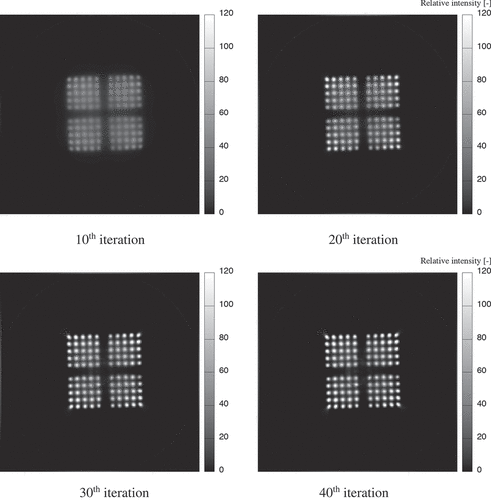
Figure 5. The projected relative intensity of 60Co in conventional MRPEM. (Iteration number: 10, 20, 30 and 40).

On the other hand, as a representative of the reconstructions using the integrated MRPEM, showed the spatial rod-wise intensity distributions using the expectation distribution (ηj) at 5th. And showed relative projected intensity over one direction. Noise components except for gamma emitter regions decreased and relative intensity at each of pins became larger in comparison with . Hence, the rebuilt distributions in integrated MRPEM were certainly superior compared to standard MRPEM.
5. Discussion and conclusion
Fast reconstruction algorithm was successfully integrated into MRPEM, and then the passive gamma emitter distribution was rebuilt using sinogram data of 10 × 10 BWR mock-up fuel assembly. Compared to standard MRPEM, the integrated MRPEM made it possible to achieve 20% reduced MAE spatial distributions of passive gamma-ray intensity. With W(ηj), the fast reconstruction processing led to reduce of iteration number for the GET using MRPEM, which also suppressed noise components except for 60Co pin regions. However, it was found that MAEs in reconstructed distributions might increase slightly after 30 iterations in due to ηj in W(ηj). Thus, passive gamma-ray distributions could be recreated within 10 iterations after using W(ηj) was introduced into the MRPEM algorithm.
Acknowledgments
The authors are grateful to IAEA challenge staff for providing sinogram data treated in IAEA tomography reconstruction and analysis. This work was supported by JSPS KAKENHI Grant Number JP17K07005.
Disclosure statement
No potential conflict of interest was reported by the authors.
Additional information
Funding
References
- IAEA Department of Safeguards Long-Term R&D Plan, 2012–2023, STR-375 IAEA, 2013.
- Smith EL. A viability study of gamma emission tomography for spent fuel verification: JNT 1955 Phase I technical report. USA: Pacific Northwest National Raboratory; October 2016, (PNNL-25995); p. 62.
- Willman C. Applications of gamma ray spectroscopy of spent nuclear fuel for safeguards and encapsulation. Digital Comprehensive Summaries of Uppsala Dissertations from the Faculty of Science and Technology, 212.
- Svärd S, Holcombe S, Grape S. Applicability of a set of tomographic reconstruction algorithms for quantitative SPECT on irradiated nuclear fuel assemblies. Nucl Instrum Methods Phys Res A. 2015;783:128–141.
- Honkamaa T. IAEA Safeguards Symposium; 2014.
- Green PJ. Bayesian reconstructions from emission tomography data using a modified EM algorithm. IEEE Trans Med Imaging. 1990;9:84–93.
- Shiba S, Sagara H. Development of image reconstruction technology using passive gamma emission tomography. Proceedings of the INMMJ2018, Tokyo, Japan; 2018 Nov 11–12; p. 3.
- Bruyant PP. Analytic and iterative reconstruction algorithms in SPECT. J Nucl Med. 2002;43:1343–1358.
- Ohura N, Ogawa K, Kunieda E. Fast vascular reconstruction with MAP-EM method from few projections. Conference Record of 1999 IEEE Med Imaging Conference; Seattle (WA);1999. p. 1168–1172.

